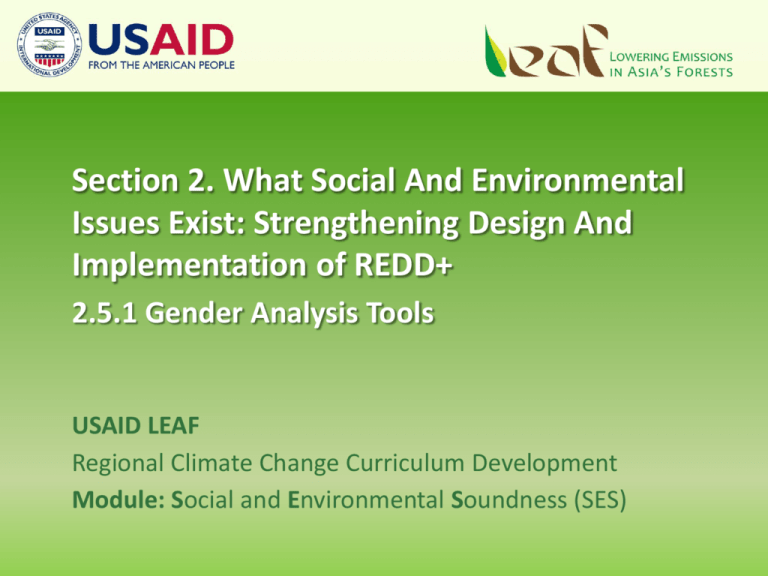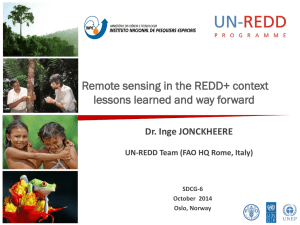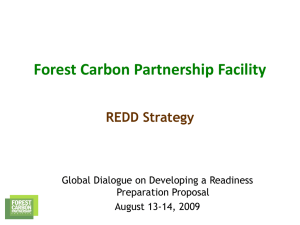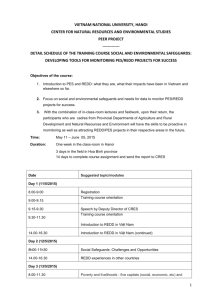SES_2.5.1_Gender_Analysis_Tools_2015_04
advertisement

Section 2. What Social And Environmental Issues Exist: Strengthening Design And Implementation of REDD+ 2.5.1 Gender Analysis Tools USAID LEAF Regional Climate Change Curriculum Development Module: Social and Environmental Soundness (SES) Name Affiliation Kasetsart University, Thailand Penporn Janekarnkij; Co-Lead Kasetsart University, Thailand Surin Onprom; Co-Lead Name Affiliation Tran Thi Thu Ha Vietnam Forestry University Nguyen Dinh Hai Vietnam Forestry University Rejani Kunjappan; Co-Lead RECOFTC Thailand Vo Mai Anh Vietnam Forestry University Claudia Radel; Co-Lead Utah State University Tran Tuan Viet Vietnam Forestry University Sarah Hines; Co-Lead US Forest Service Cao Tien Trung Vinh University, Vietnam Sidthinat Prabudhanitisarn Chiang Mai University, Thailand Nguyen T. Trang Thanh Vinh University, Vietnam Sharifah Zarina Syed Zakaria University Kebangsaan Malaysia Nguyen Thu Ha USAID Vietnam Forests & Deltas Mohd Rusli Yacob University Putra Malaysia Maeve Nightingale IUCN MFF Kaisone Phengspha National University of Laos Guada Lagrada PACT MPE Phansamai Phengspha National University of Laos Le Van Trung DARD Lam Dong Kethsa Nanthavongduangsy National University of Laos Nguyen Thi Kim Oanh AIT Thailand Freddie Alei University of Papua New Guinea David Ganz USAID LEAF Bangkok Chay Kongkruy Royal University of Agriculture, Cambodia Kalpana Giri USAID LEAF Bangkok Soreivathanak Reasey Hoy Royal University of Phnom Penh, Cambodia Chi Pham Project Coordinator USAID LEAF Bangkok I. INTRODUCTION AND BACKGROUND 1.1. 1.2. 1.3. 1.4. Introduction to Climate Change The Climate Change Mitigation & Adaptation Context Introduction to Social and Environmental Soundness (SES) Guiding Frameworks – Sustainable Development & Ethics II. WHAT SOCIAL AND ENVIRONMENTAL ISSUES EXIST: STRENGHENING DESIGN AND IMPLEMENTATION OF REDD 2.1. Environmental Co-benefits: Introduction to Biodiversity and Ecosystem Services 2.1.1. Carbon/REDD+ Project Accounting, Carbon Monitoring & MRV 2.2. Governance 2.2.1. Regulatory Framework, Forest Tenure, and Carbon Rights 2.3. Stakeholder Participation 2.3.1. FPIC 2.4. Social Co-benefits 2.5. Gender Equity and Women’s Empowerment 2.5.1. Gender Analysis Tools 2.6. 2.7. 2.8. 2.9. 2.5.2. Women’s Empowerment in Agriculture Index Indigenous Peoples and their Empowerment Local Livelihoods: An Introduction 2.7.1 Livelihoods impact Case Study: April Salumei, PNG REDD+ Benefits Sharing Economic and Financial Viability and Sustainability III. STATE OF THE ART IN ACTION: BRINGING THE PIECES TOGETHER 3.1. Safeguard Mechanisms in REDD+ Programs 3.2. Streamlining of Safeguards and Standards 3.3. Developing National Level Safeguards At the end of this section, learners will be able to: Understand the importance of gender equality and women’s empowerment in climate change context Explain the concept of gender mainstreaming Explain the purpose and domains of gender analysis in development projects Apply a gender analysis tool (the Harvard Framework) to integrate gender related considerations into climate change mitigation and REDD+ projects Content presentation Brainstorming Group exercise Case study assignment Read: 1. Gurung, J. et al. 2011. Getting REDD+ Right for Women: An analysis of the barriers and opportunities for women's participation in the REDD+ sector in Asia. USAID, WOCAN, USFS. (Read the executive summary). 2. UN-REDD program. 2013. Guidance Note on Gender Sensitive REDD+. UNDP, FAO, UNEP. Why are women in Thailand still considered the HIND legs of elephant? (despite having good education and access to labor market) Why are women considered misfit for forestry education? Why can women in Saudi Arabia not drive a car? Why does the scoping team of a donor agency not consult with the women’s ministry while discussing climate change mitigation and REDD+? Gender: The experience of being female or male • Differs from culture to culture Gender is established through a socialization process: • The process whereby women and men learn the “proper” ways a woman or a man should think, feel, and behave • Maintains a patterned consistency so that one can predict, within limits, how people (men/women) behave, think and feel. • DEFINES WHAT IS CONSIDERED “NORMAL”! Defined behavior/thinking for women and men = Gender roles Defined tasks, responsibilities for women and men = Gender division of labor Defined access to and control of property/opportunities = Gendered access & control Individuals: Women, men, girls, boys, since these all perform the patterned behaviors, roles and relations. E.g. Culture mandates behavior, roles and relations. Many of these cultural values may be discriminatory to either of the sexes. It is through culture that individuals are socialized. As a result of socialization, people acquire norms, values and cultural practices, and unwittingly integrate this into their cognitive, affective and behavioral systems. They carry assumptions and think those assumptions are NATURAL & NORMAL. Organizations: Individual persons inevitably bring this culture to all of their social interactions, including their organizations. Organization’s culture becomes gender biased. Organization does not address gender issues because everything seems NORMAL & NATURAL. Do you think gender equality is important in the climate change context? Give justifications or visual demonstrations for your answer. You have 15 minutes to discuss in small groups and 5 minutes to present a summary to the full class. Gender inequality is more pervasive than other forms of inequality. Gender inequality cuts across all other forms of inequality so that it is a feature of rich as well as poor groups, racially dominant as well as sub-ordinate groups, privileged as well as ‘untouchable’ castes. Gender inequality structures the relations of production and reproduction in different societies. Gender differences can lead to inequalities in the receipt of co-benefits from REDD+ activities. Gender Mainstreaming: Means making women’s as well as men’s concerns, needs and experiences an integral part of policies, programs and projects so that women and men can benefit equally. In practice, means systematically identifying gaps in gender equality and consequently addressing them. Source of gaps: rights, control, ownership, power, opportunities, etc. • Promote gender equality Equality Sameness • Equality: The state or condition that affords women and men equal enjoyment of human rights, socially-valued goods, opportunities and resources. • And Women’s Empowerment is necessary because….. women (in many regions/context) are: • Not just different, but UNEQUAL, • Not just UNEQUAL, • But SUBORDINATE. Gender Analysis Program Cycle Analysis Implementation Gaps in the status and participation of women and men could hinder overall project outcomes Gender mainstreaming strategies Project outcomes that may close the gaps in the status and participation of women and men Gender mainstreaming entry points Possible differential effects the project might have on men and women Specific measures to avoid/ mitigate potential gender constraints that may be caused by the project M&E Gender disaggregated data (quantitative) Gender scanning checklist (qualitative) Read the example gender analysis report and discuss in groups: What is gender analysis? What contents/elements do you expect to get from gender analysis? When and in what topic is gender analysis needed? Why? What are the risks that might affect the quality of gender analysis? Gender analysis is a subset of socio-economic analysis to identify, understand, and explain: gaps between men and women in households, communities, and countries the relevance of gender norms and power relations in a specific context These gaps can lead to men and women getting different co-benefits from REDD+ activities. Social status Leadership /decision making Access Division of labor GENDER ANALYSIS Program impacts Laws, Policies, Regulations, and Institutional Practices (implicit and explicit gender biases) Cultural Norms and Beliefs (effects on potential participation of males and females in the project activities) Gender Roles, Responsibilities, and Time Used (paid work, unpaid work, and community service) Access to and Control over Assets and Resources (assets, social benefits, public services and technology/information) Patterns of Power and Decision-making (decision making and control over material, human, intellectual, and financial resources) Disaggregated by: Gender Age Social economic status Ethnicity Disability status Location and other socially relevant category as appropriate Harvard Analytical Framework (economic efficiency) DPU (Development Planning Unit) Frameworks Moser (triple roles) Framework Levy (web of institutionalization) Framework Gender Analysis Matrix (GAM) Equality and Empowerment Framework (Longwe) Capacities and Vulnerabilities Framework (CVA) People Oriented Framework (POP) Social Relations Framework (SRF) Women’s Empowerment in Agriculture Index, or WEAI (SES module section 2.5.2) Identifies all relevant productive, reproductive, and community tasks Addresses the question: who does what? Detail needed depends upon nature of project. Those areas of activity in which the project will be directly involved require the greatest details. Gender and age details are particularly important. Time/seasonal allocations for activities are helpful. Activity locus is helpful: where is the activity carried out? Production This includes the production of goods and services for income or subsistence. It is the work done which is mainly recognized and valued as work by individuals and societies, and which is most commonly included in national economic statistics. Both women and men perform productive work, but not all of this is valued in the same way. Reproduction This encompasses the care and maintenance of the household and its members, such as cooking, washing, cleaning, nursing, bearing children and looking after them, building and maintaining shelter. This work is necessary, yet it is rarely considered of the same value as productive work. It is normally unpaid and is not counted in conventional economic statistics. It is mostly done by women. Community This includes all the community activities that household members engage in. These could include communal labor, attending religious ceremonies, marriages, political meetings, training workshops and so forth. Lists resources used to carry out activities in Activity Profile. Indicates where women or men have access to resources, who controls their use, and who controls the benefits of a household’s/ community’s resource use. Access: ability to use a resource Control: deciding authority over a resource The person/institution who controls a resource is the one ultimately able to make decisions about its use, including whether it can be sold. Forestry Resources Access W • Forest land rights • Markets for NTFPs • Labor for NTFP collection • Cash from NTFP sales • Trainings on forest management and marketing Control M W Benefits M Control depends on what type of land it is: private, local community, or local government, etc. • Outside income • Asset ownership • Basic needs (food, clothing, shelter, etc.) • Exposure to new ideas and knowledge • Increased decision making capability • Political power/ prestige • Other Examples: Community norms & social hierarchies, such as family/community forms, cultural practices, and religious beliefs Demographic conditions Institutional structures, including the nature of government bureaucracies, and arrangements for the generation and dissemination of knowledge, skills, and technology General economic conditions, such as poverty levels, inflation rates, income distribution, international terms of trade, and infrastructure Internal and external political events Legal parameters Training and education Attitude of community to development/assistance workers INFLUENCING FACTORS CONSTRAINTS OPPORTUNITIES • community norms and social hierarchy • demographic factors • institutional structures • economic factors • political factors • legal parameters • training • attitude of community to • development workers • Resistance to new ideas and social change • Low capacity of community members to implement new knowledge • National policy for gender equality • Innovative training programs • Funds for programs etc. ADVANTAGES: Provides clear information on the gender division of labor and makes women’s work visible Makes a distinction between access to and control over resources More useful for projects than for programs, as it depends on micro-level analysis Can be adapted and used, for example, with the Moser Framework for deeper practical and strategic gender needs assessment POTENTIAL LIMITATIONS: Efficiency rather than equity oriented Can be carried out in a non-participative way without the involvement of women and men from a community 30 Examples of Participatory Rural Appraisal (PRA) tools: Season calendar Village mapping Time trend/ history chart Venn diagram Problem trees Resource map Other important qualitative research tool: Semi Structured Interview: Household Case Study Typology Female headed monoparental household Poor farmer households Small farmer households Medium producers Farmer households where women possess own Málaga crop Socio-economic How are characteristics of women the household involved? Access to and control over resources by women Impact on the lives of men and women To show how groups of individuals in the community relate to each other To explore the division of labor between men and women To identify the differences in the use and control of resources between men and women To break down and understand the resources available in the community Frameworks, matrices and tools are merely a means to an end. They need to be used with flexibility and creativity, adapted to the needs of local socio-cultural and linguistic contexts, and the overall research questions and the project implementation goals. Translation and use of local language need to be conducted carefully. Efficiency of the framework and tools depend vitally on research skills such as listening, building rapport, discussing and learning from the respondents. Task: Apply the Harvard Framework for gender analysis in a forestry/REDD+ project context. Purpose: Illuminate various activities done by women and men, not captured by the “cash economy”. Task: Plan for gender mainstreaming in a REDD+ project by preparing a 1-page action plan. How: Use the Oddar Meanchy project in Cambodia as a Case Study (read the gender analysis findings for the project). Purpose: Practice preparing an action plan for gender mainstreaming based on the findings from a gender analysis. Gender is important in a climate change context, just as it is in all aspects of social life. Gender mainstreaming integrates consideration of gender into all aspects of policies, programs, or projects, including under REDD+, to promote gender equality. Gender analysis is used to identify and understand gaps between men and women. These gaps can lead to men and women getting different co-benefits from REDD+ activities. Various gender analysis frameworks exist, one of which is the Harvard Analytical Framework. A number of tools exist that can be employed to collect data as an input into gender analysis frameworks. 1. Behrman, J. et al, eds. 2012. A Toolkit on Collecting Gender & Assets Data in Qualitative & Quantitative Program Evaluations. Gender, Agriculture, & Assets Project (GAAP), IFPRI and ILRI. http://gaap.ifpri.info/files/2010/12/GAAP_Toolkit_Feb_14.pdf 2. Bradley, Amanda et al. 2013. Gender and REDD+: An Assessment in the Oddar Meanchey Community Forestry REDD+ Site, Cambodia. WOCAN, PACT. 3. CGIAR. 2013. Gender Strategy for the CGIAR Research Program on Forests, Trees and Agroforestry (CRP-FTA). CIFOR, CGIAR. 4. FAO. Gender-Sensitive Indicators for Natural Resources Management. Gender and Population Division, Sustainable Development Department, Food and Agriculture Organization of the United Nations. 5. Giri, K. 2012. LEAF Gender Mainstreaming Strategy and Checklist. USAID LEAF. (provides rationale and practical steps for integrating gender considerations in a climate change mitigation project). 6. Govinda, R. 2012. Mapping 'Gender Evaluation' in South Asia. Indian Journal of Gender Studies. 19: 187. 7. Gurung, J. et al. 2011. Getting REDD+ Right for Women: An analysis of the barriers and opportunities for women's participation in the REDD+ sector in Asia. USAID, WOCAN, USFS. 8. ICRAF and WOCAN. 2012. Proceedings of the “Workshop on Integrating Gender into the R&D Cycle and the Organization”. 9. Murthy, R. K. 2012. Reflections on a Decade of Evaluation of Micro-finance and Livelihood Projects from a Gender and Equity Lens. Indian Journal of Gender Studies. 19: 279. 10. Ochola, W., Sangiinga, P., and Bekalo, I., eds. 2010. Managing Natural Resources for Development in Africa: A Resource Book. University of Nairobi Press. http://www.idrc.ca/EN/Resources/Publications/openebooks/506-9/index.html 11. Slocum, R., Wichhart, L., Rocheleau, D., and Thomas-Slayter, B. eds. 1995. Power, process and participation: tools for change. Intermediate Technology Publications. 12. Sudarshan, R. and D. Sharma. 2012. Gendering Evaluations: Reflections on the Role of the Evaluator in Enabling a Participatory Process. Indian Journal of Gender Studies. 19: 303. 13. UN-REDD program. 2013. Guidance Note on Gender Sensitive REDD+. UNDP, FAO, UNEP. 14. UN-REDD program. 2013. Lessons Learned (Asia-Pacific) Gender Equality & Women’s Empowerment: Women in REDD+. UNDP, FAO, UNEP. 15. UN-REDD program, USAID, WOCAN. 2013. Scoping Study of Good Practices for Strengthening Women’s Inclusion in Forest and Other Natural Resource Management Sectors. 16. UN-REDD program, USAID, WOCAN. 2013. Women’s Inclusion in REDD+ in Cambodia: Lessons from Good Practices in Forest, Agriculture and Other Natural Resources Management Sectors. 17. USAID. USAID Gender Term Definitions. http://agrilinks.org/sites/default/files/resource/files/USAID_Gender_TermDefinitio ns.pdf 18. USAID. 2013. ADS Chapter 205: Integrating Gender Equality and Female Empowerment in USAID’s Program Cycle. http://www.usaid.gov/sites/default/files/documents/1870/205.pdf








